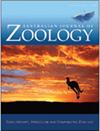Ghost bats exhibit informative daily and seasonal temporal patterns in the production of social vocalisations
IF 1
4区 生物学
Q3 ZOOLOGY
引用次数: 4
Abstract
Abstract. The ghost bat (Macroderma gigas) is a colonial and highly vocal species that is impacted by human visitation of caves. The ability to document behaviours inside the roost by recording vocalisations could provide an important new tool for the management of this disturbance-prone species by removing the need for in-person confirmation of reproductive activity, and, in turn, identifying roosts of conservation importance. To assess whether vocalisations are indicators of daily and seasonal behavioural events, we aimed to determine whether total vocal activity significantly varied by time of day and time of year and, further, how the relative frequencies of occurrence of three common social vocalisations (‘Chirp-trill’, ‘Squabble’ and ‘Ultrasonic Social’) aligned with previously reported seasonal reproductive behaviour. We recorded sound inside the largest known maternity roost, extracted all vocal signals and classified them into types using semiautomated methods. Total vocal activity varied significantly by time of day and time of year, peaking around sunrise and sunset, and during the mating and nursing seasons. The relative frequencies of occurrence of vocalisation types varied significantly seasonally, with the Chirp-trill and Squabble produced most during the mating season and first flight periods, whereas the Ultrasonic Social peaked during parturition and weaning periods. This timing aligns with a previously suggested vocalisation function, providing further evidence that these signals are important in mating and maternity behaviours. Further, this suggests that peaks in the relative frequency of occurrence of distinct social vocalisations may act as indicators of in-roost reproductive and pup development behaviours and provides a low-disturbance, semiautomated method for using long-term acoustic recordings to study and monitor behaviour in this sensitive species.鬼蝠在社会发声方面表现出信息丰富的日常和季节性时间模式
摘要鬼蝠(巨蝠)是一种殖民地和高度发声的物种,受到人类访问洞穴的影响。通过记录发声来记录栖息地内的行为,可以为管理这种易受干扰的物种提供一个重要的新工具,因为它不需要亲自确认繁殖活动,反过来,也可以确定具有保护重要性的栖息地。为了评估发声是否是日常和季节性行为事件的指标,我们的目标是确定总发声活动是否随着一天中的时间和一年中的时间而显著变化,此外,三种常见的社会发声(“唧唧颤音”、“争吵”和“超声波社会”)的相对发生频率如何与先前报道的季节性生殖行为相一致。我们记录了已知最大的母性栖息地的声音,提取了所有的声音信号,并使用半自动方法将它们分类。总声音活动在一天中的不同时间和一年中的不同时间变化很大,在日出和日落时达到顶峰,在交配和哺乳季节。鸣叫类型的相对频率有明显的季节变化,啁啾-颤音和口角在交配季节和首次飞行期间产生最多,而超声波社会在分娩和断奶期间达到高峰。这个时间与之前提出的发声功能一致,进一步证明了这些信号在交配和生育行为中很重要。此外,这表明不同社会发声的相对频率的峰值可能作为巢内繁殖和幼崽发育行为的指标,并为使用长期声学记录来研究和监测这种敏感物种的行为提供了一种低干扰、半自动化的方法。
本文章由计算机程序翻译,如有差异,请以英文原文为准。
求助全文
约1分钟内获得全文
求助全文
来源期刊
CiteScore
2.40
自引率
0.00%
发文量
12
审稿时长
>12 weeks
期刊介绍:
Australian Journal of Zoology is an international journal publishing contributions on evolutionary, molecular and comparative zoology. The journal focuses on Australasian fauna but also includes high-quality research from any region that has broader practical or theoretical relevance or that demonstrates a conceptual advance to any aspect of zoology. Subject areas include, but are not limited to: anatomy, physiology, molecular biology, genetics, reproductive biology, developmental biology, parasitology, morphology, behaviour, ecology, zoogeography, systematics and evolution.
Australian Journal of Zoology is a valuable resource for professional zoologists, research scientists, resource managers, environmental consultants, students and amateurs interested in any aspect of the scientific study of animals.
Australian Journal of Zoology is published with the endorsement of the Commonwealth Scientific and Industrial Research Organisation (CSIRO) and the Australian Academy of Science.

 求助内容:
求助内容: 应助结果提醒方式:
应助结果提醒方式:


